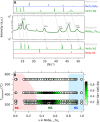Negative-pressure polymorphs made by heterostructural alloying
- PMID: 29725620
- PMCID: PMC5930396
- DOI: 10.1126/sciadv.aaq1442
Negative-pressure polymorphs made by heterostructural alloying
Abstract
The ability of a material to adopt multiple structures, known as polymorphism, is a fascinating natural phenomenon. Various polymorphs with unusual properties are routinely synthesized by compression under positive pressure. However, changing a material's structure by applying tension under negative pressure is much more difficult. We show how negative-pressure polymorphs can be synthesized by mixing materials with different crystal structures-a general approach that should be applicable to many materials. Theoretical calculations suggest that it costs less energy to mix low-density structures than high-density structures, due to less competition for space between the atoms. Proof-of-concept experiments confirm that mixing two different high-density forms of MnSe and MnTe stabilizes a Mn(Se,Te) alloy with a low-density wurtzite structure. This Mn(Se,Te) negative-pressure polymorph has 2× to 4× lower electron effective mass compared to MnSe and MnTe parent compounds and has a piezoelectric response that none of the parent compounds have. This example shows how heterostructural alloying can lead to negative-pressure polymorphs with useful properties-materials that are otherwise nearly impossible to make.
Figures




References
-
- K. Vonnegut, Cat’s Cradle (Holt, Rinehart & Winston, 1963).
-
- Goresy A. E., Chen M., Dubrovinsky L., Gillet P., Graup G., An ultradense polymorph of rutile with seven-coordinated titanium from the Ries crater. Science 293, 1467–1470 (2001). - PubMed
-
- Friedman S. H.,. The four worlds of carbon. Nat. Chem. 4, 426–426 (2012). - PubMed
-
- Fujishima A., Honda K., Electrochemical photolysis of water at a semiconductor electrode. Nature 238, 37–38 (1972). - PubMed
Publication types
LinkOut - more resources
Full Text Sources
Other Literature Sources

